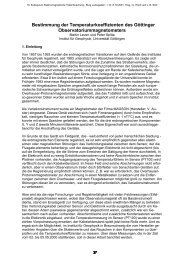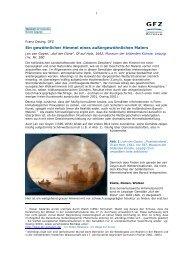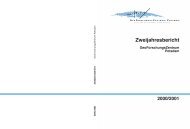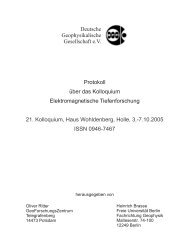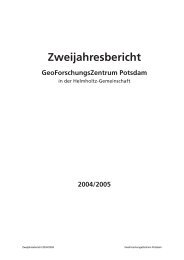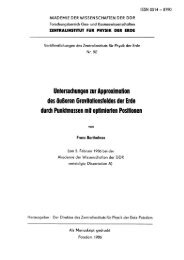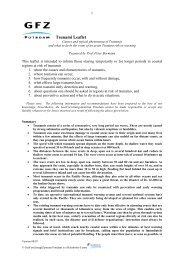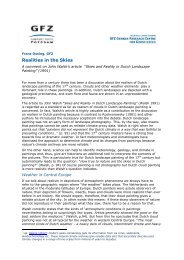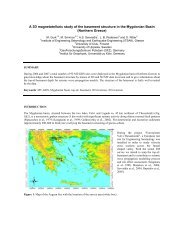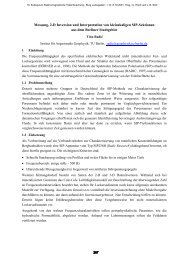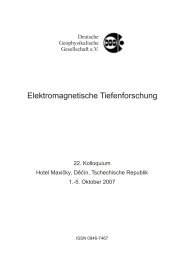Cave detection using the Self-Potential-Surface (SPS) technique on ...
Cave detection using the Self-Potential-Surface (SPS) technique on ...
Cave detection using the Self-Potential-Surface (SPS) technique on ...
Create successful ePaper yourself
Turn your PDF publications into a flip-book with our unique Google optimized e-Paper software.
19. Kolloquium Elektromagnetische Tiefenforschung, Burg Ludwigstein, 1.10.-5.10.2001, Hrsg.: A. Hördt und J. B. Stoll<br />
Figure 9: Comparis<strong>on</strong> of <str<strong>on</strong>g>SPS</str<strong>on</strong>g> slices of Fig 8 (x=<br />
1,2, …,10, blue, respectively thin lines) and its<br />
visual average (red, respectively thick line) with <str<strong>on</strong>g>the</str<strong>on</strong>g><br />
crosscut based <strong>on</strong> speological data of <str<strong>on</strong>g>the</str<strong>on</strong>g> cave taken<br />
from Fig. 5.<br />
6 Discussi<strong>on</strong><br />
By definiti<strong>on</strong>, <str<strong>on</strong>g>the</str<strong>on</strong>g> <str<strong>on</strong>g>SPS</str<strong>on</strong>g> <str<strong>on</strong>g>technique</str<strong>on</strong>g> does not account<br />
for any inhomogeneities, such as a cave.<br />
Theoretically, <str<strong>on</strong>g>the</str<strong>on</strong>g> method should have failed.<br />
However, to explain our experimental observati<strong>on</strong><br />
at surface we divide <str<strong>on</strong>g>the</str<strong>on</strong>g> problem into an active and<br />
static part. The active part comprises <str<strong>on</strong>g>the</str<strong>on</strong>g><br />
mechanism that creates a charge accumulati<strong>on</strong> al<strong>on</strong>g<br />
<str<strong>on</strong>g>the</str<strong>on</strong>g> <str<strong>on</strong>g>SPS</str<strong>on</strong>g>, whereas <str<strong>on</strong>g>the</str<strong>on</strong>g> passive part explains how this<br />
charge distributi<strong>on</strong> is mirrored to <str<strong>on</strong>g>the</str<strong>on</strong>g> surface. The<br />
latter questi<strong>on</strong> can be qualitatively explained in<br />
terms of a capacitor with various dielectric media:<br />
Static model for a subhoriz<strong>on</strong>tal layered structure<br />
without a cave<br />
We state that <str<strong>on</strong>g>the</str<strong>on</strong>g> K factor, as defined in <str<strong>on</strong>g>the</str<strong>on</strong>g> original<br />
idea by Aubert et al. (1990) and Aubert & Atangana<br />
(1996) for a subhoriz<strong>on</strong>tal layered structure of<br />
homogenious media, is similar to <str<strong>on</strong>g>the</str<strong>on</strong>g> electric field<br />
strength in a capacitor (Fig. 10 a)):<br />
EF ≅ K . (5)<br />
E F electrical field strength<br />
A area<br />
Q charge<br />
D displacement of charge<br />
d distance<br />
ε 0 electrical permittivity of vacuum<br />
1 −9<br />
As<br />
( 10 )<br />
36π<br />
Vm<br />
ε r relative electrical permittivity<br />
( ε lim est<strong>on</strong>e = 8 – 12, ε water = 80, ε air =1)<br />
V potential<br />
(Values taken from Landolt & Börnstein<br />
(1952))<br />
Figure 10: a) Capacitor without and b) capacitor with a dielectric media. c) Capacitor with a series of<br />
dielectric media.



